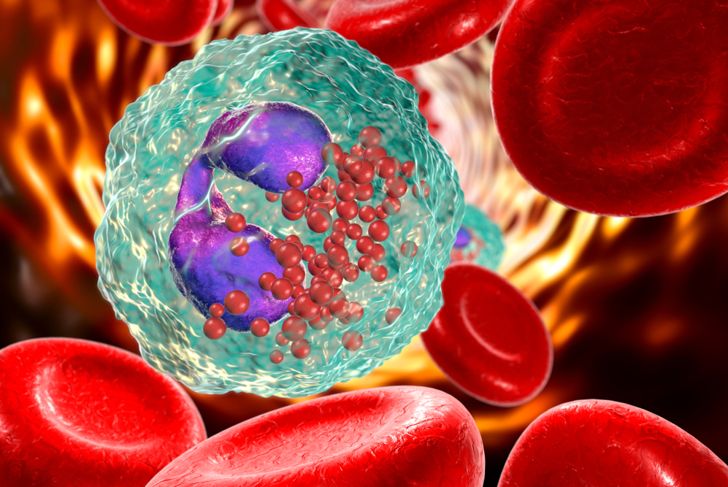Asthma is a fairly common condition that affects between 8 and 10 percent of people in the U.S. Over the last few decades, research has suggested that it is not a single condition but many, with varying causes and overlapping symptoms. One subtype is eosinophilic asthma, which affects the whole respiratory tract and is so called because it is due to an increase in eosinophils in the lung tissue, sputum, and blood.
Eosinophilic Asthma vs Non-Eosinophilic Asthma
Eosinophilic asthma and non-eosinophilic asthma have many overlying symptoms, but [https]are quite different in how they affect the respiratory system. In eosinophilic asthma, white blood cells called eosinophils cause inflammation in the airways, leading to asthma symptoms. Non-eosinophilic asthma results from a reaction involving a variety of cells, but not eosinophils.
Eosinophils
Eosinophils are specialized white blood cells formed in the bone marrow that play an important role in many inflammatory processes, including allergic reactions. Eosinophils are generally helpful, trapping substances and killing harmful cells, like bacteria and parasites. In some cases, as in eosinophilic asthma, they accumulate in excess and become harmful.
Symptoms
Symptoms of eosinophilic asthma overlap with those of other forms of asthma, although this form is associated with more frequent acute attacks and reduced quality of life. The symptoms include shortness of breath, difficulty breathing, coughing, or wheezing. Someone with eosinophilic asthma may have chest tightness and abnormalities or obstructions in the lungs. The inside of the nose may be inflamed, and they may have nasal polyps and chronic nasal infections.
Importance of Diagnosis
About 10 to 20 percent of asthma cases are poorly controlled; identifying the specific type of asthma someone has can help find appropriate and effective interventions. A one-size-fits-all treatment for non-eosinophilic and eosinophilic asthma is unlikely to work as the inflammation in each type results from different triggers and is caused by different types of cells.
Diagnosis
Diagnosing eosinophilic asthma requires measuring the number of eosinophils in the body. Sometimes, this is done using a blood test, though this is not the most accurate way, as many things can lead to elevated eosinophils in the body. Another approach is collecting a sputum sample and examining it under a microscope to look for eosinophils. Doctors can also collect fluid or a tissue sample from the lungs to look for eosinophils, but this procedure is invasive and requires anesthesia.
Treatment
To treat eosinophilic asthma, doctors focus on controlling the patient’s breathing as well as reducing the number of eosinophils in the airway. Oral corticosteroids can control inflammation, especially when combined with inhaled steroids and bronchodilators to open the airway. Biologic medications can block the inflammatory response in eosinophilic asthma. Many types are available. They are usually administered via IV induction or injection, and depending on the specific medication, can last anywhere from 2 to 8 weeks.
Status Asmaticus
The most dangerous complication of any type of asthma is status asthmatics. This condition occurs when the airway is severely obstructed, and the symptoms do not respond to regular treatment. Status asthmaticus can occur with little warning and progress quickly. Signs include significant shortness of breath at rest, chest pain, blue lips and face, confusion, and severe anxiety from being unable to breathe. These signs indicate a life-threatening condition, and anyone experiencing them should go to the ER right away.
Other Complications
Complications of eosinophilic asthma include permanent changes to the structure and function of the lungs. Someone with this condition may experience exhaustion due to lack of sleep from symptoms at night. They may also have a persistent cough and be unable to take part in physical activities or have decreased exercise tolerance.
Outlook
Death from asthma is rare, but people with asthma often have a decline in lung function earlier than people without the condition. Asthma flares can be frightening, and if uncontrolled or poorly controlled, the condition can drastically affect daily life. Many cases of eosinophilic asthma are controlled well with steroids, but some people do not respond to conventional treatments and need additional interventions, such as biological therapies.
Management and Lifestyle Changes
In addition to medical management, some lifestyle changes can help manage eosinophilic asthma. Use allergy-proof covers on mattresses to prevent irritation from dust mites and remove carpets from bedrooms if possible. Choose unscented cleaners and use a dehumidifier to keep the indoor air dry. Regularly changing filters in air conditioners and heaters can also help. Stopping smoking is the most important thing people can do to control their own asthma or help someone in their family who has asthma.

 Home
Home Health
Health Diet & Nutrition
Diet & Nutrition Living Well
Living Well More
More




















